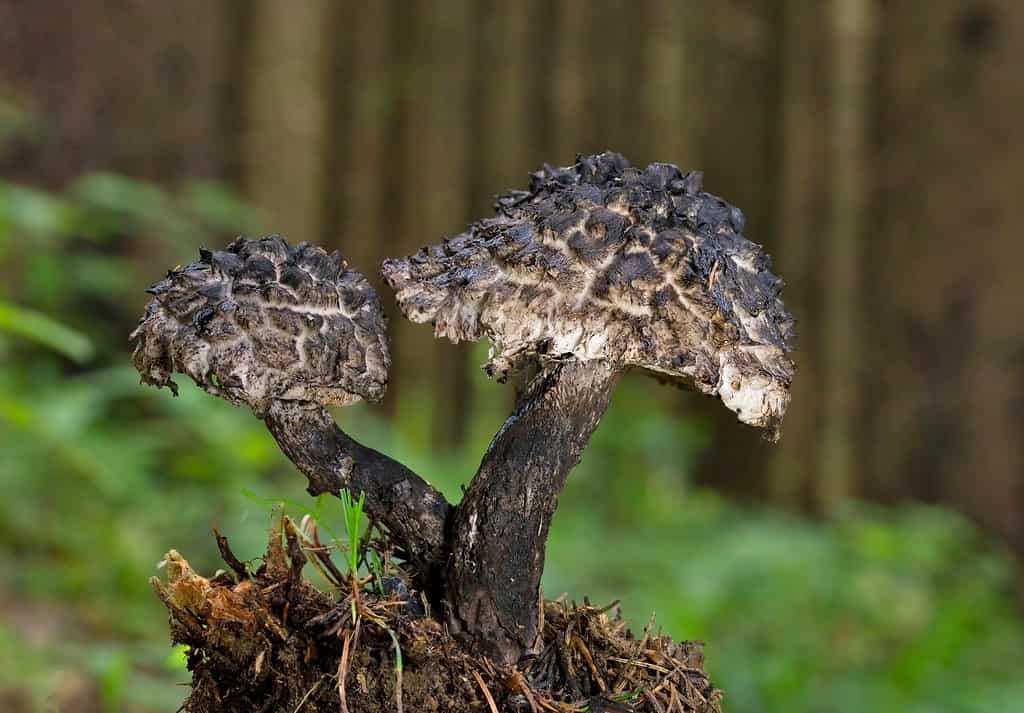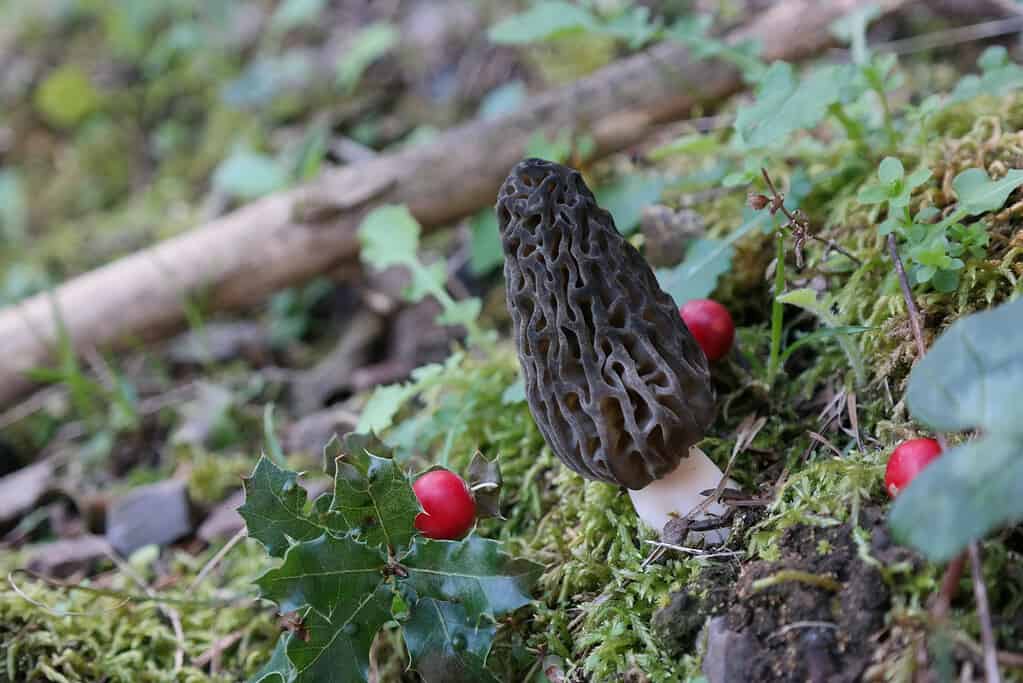The world of mushrooms features an incredible array of diversity in morphological characteristics. The fascinating fruiting bodies of fungi come in a range of shapes, sizes, and colors. They have evolved a range of chemical defenses, spore dispersal strategies, and ecological roles. Black mushrooms feature a range of physical characteristics and exist across a number of fungal families. In this guide, we’ll explore three types of black mushrooms and discuss their morphological characteristics, native distribution, ecological roles, and human uses.
Read on to learn more.
1. Types of Black Mushrooms: Eastern Black Trumpet (Craterellus fallax)
The eastern black trumpet mushroom (Craterellus fallax), also known as the horn of plenty, is native to eastern North America. This species of mushroom is part of the Cantharellaceae family of which chanterelles (Cantharellus) are a part. Older field guides typically list the eastern black trumpet as the black trumpet of Europe (Craterellus cornucopiodies). In recent years, however, mycologists have discovered that Craterellus cornucopiodies likely only exists in Europe and the specimens in the Americas are distinct species.
Morphological Characteristics
As its common name suggests, Craterellus fallax features a black, trumpet-shaped fruiting body that is hollow and deeply vase-shaped. Young individuals are more tubular in appearance. As the mushroom ages, the fruiting body presents a more distinct, funnel-shaped cap with margins that roll under. The margins are usually the darkest in black coloration while the rest of the fruiting body features pale grey to pale black coloration. The cap reaches up to about 2 inches wide. Overall, the fruiting body can grow to 3.5 inches in height. The flesh is notably thin and fragile. If you take a spore print of the eastern black trumpet, you’ll note it is pale pinkish-orange. The underside of the fruiting body is either pale or slightly wrinkled.
Ecology
The eastern black trumpet is a mycorrhizal species. Mycorrhizal fungi engage in plant-fungi partnerships in which the roots of the plant and the fungi’s mycelium exchange nutrients. The plant roots exchange carbon and sugars while the mycelium provides nutrients like phosphorus and nitrogen. Mycelium describes the underground, filamentous part of the fungus. Since they don’t obtain their nutrients from decaying organic matter, mycorrhizal mushrooms don’t grow on stumps, logs, attached to trees, in mulch, manure piles, etc. Instead, they appear fruiting directly from the forest floor, meadow, etc.
In the case of Craterellus fallax, the mycelium is mycorrhizal with oaks and possibly other hardwood trees. It fruits early to late summer. This species may grow alone, scattered, and in loose clusters across the forest floor near its tree associations.
Human Uses
Largely, humans use the eastern black trumpet for culinary purposes. It is a highly sought-after edible mushroom. Since it depends on a complicated mycorrhizal relationship to produce fruit, people have not yet discovered how to reliably cultivate eastern black trumpets. Black trumpets are delectable in a range of dishes such as creamy pasta, stir-fries, and wild rice with caramelized shallots.

Some people say that black trumpets are more flavorful after they’ve been dehydrated.
©Lorenzo Martinelli/Shutterstock.com
2. Types of Black Mushrooms: Old Man of the Woods (Strobilomyces floccopus)
A delightful and edible member of the bolete order (Boletales), old man of the woods (Strobilomyces spp.) represents a group of similar-looking species. This genus of wooly mushrooms exists across forested, temperate regions of Europe, North America, and limited areas of Central and East Asia. In this guide, we’ll discuss the more commonly known species in eastern and southwestern regions of North America, Strobilomyces strobilaceus.
Morphological Characteristics
Like all species of Strobilomyces, S. strobilaceus is covered in wooly, shaggy scales. As these mushrooms age, the base color of the fruiting body changes from pale grey to dark grey-black. The cap of S. strobilaceus is convex to broadly convex. Often, pale gray fragments of the partial veil hang from the cap margin. A shaggy partial veil ring zone is sometimes visible around the stipe. The partial veil is a thin membranous tissue that covers the gills when the mushroom is immature. As it matures, the cap expands and the partial veil breaks apart. In the process, remnants of the veil may be left along the cap margin and as a ring around the upper portion of the stipe. The cap can grow to 6 inches across and the stipe can measure about 5 inches tall.
When young, the pore surface is white, but blackens with age. When cut, the flesh changes from whitish to pinkish-red to black over the course of an hour. The initial change to pink-red typically takes only a few minutes. The spore print is blackish brown to black. You’ll typically find this mushroom growing alone or scattered near hardwood trees. The very similar looking, but equally edible Strobilomyces dryophilus and Strobilomyces confusus should also be looked into if trying to be sure of exactly which species it is that you have found.
Ecology
Strobilomyces strobilaceus is mycorrhizal with hardwoods, especially beech and oak trees. It fruits in the early summer and fall and most commonly occurs east of the Rockies.
Human Uses
While edible, most foragers don’t consider old man of the woods to be a “choice edible” mushroom. However, many find the mild taste to be comparable to portobello mushrooms (Agaricus bisporus). Old man of the woods is best when harvested young before the pores turn black, and while the mushroom is still firm. Likely not firm enough to enjoy in soups, your best bet is to use old man of the woods in stir fries and sautés with garlic, onions, and firm vegetables, like broccoli, for added texture.

species can vary in color from white to black and some have more erect scales than others.
©Tintila Corina/Shutterstock.com
3. Types of Black Mushrooms: Western Black Morel (Morchella brunnea)
Broadly, morels featuring dark grey to black caps belong to the elata evolutionary clade within the genus of true morels, Morchella. In North America, there are 14 species in the elata clade, the majority of which feature dark grey-black caps. One such species of black morel is the aptly-named western black morel (Morchella brunnea).
Morphological Characteristics
Like all true morels, the western black morel features a cap with honeycomb-like ridges and pits. While some black morels often feature much lighter ridges when immature, this species typically has grey to black ridges throughout its development. The cap is conical with vertically arranged pits. When the species is young, the western black morel has dark brown to black ridges with yellowish-tan pits. As it ages, the pits typically darken to brown or yellowish brown. The stipe and cap rarely reach higher than 2 inches each in height. Like all true morels, the inside of the fruiting body is hollow.
Ecology
The ecological roles of morels throughout their life stages are still not fully understood by mycologists. It’s possible that some morels can display saprobic and mycorrhizal behaviors at various points. Saprobic fungi obtain their nutrients by breaking down dead organic matter, like deadwood, leaf litter, mulch, etc. The majority of morels seem to form some kind of association with trees, and some research suggests this relationship may be mycorrhizal. Morchella brunnea appears in spring primarily near hardwoods of western North America, especially oaks and the Pacific madrone. They may appear alone or gregariously across the forest floor. Unlike burn morels of the elata clade, the western black morel does not fruit in association with fires.
Human Uses
Morels are highly prized for their meaty texture and earthy, nutty, faintly smoky, and slightly buttery flavor profile. You can find them fresh during the spring and early summer. Year-round, you can purchase dried morels online and at international markets and health food stores. Morels are commonly used in a range of dishes including soups, stews, buttery sautés, stir-fries, and pasta dishes. Whether they are dried or fresh, make sure to thoroughly cook your morels before consuming them. Raw or undercooked morels can cause a range of GI issues and neurological symptoms.

These small black mushrooms still pack a lot of flavor.
©Konstantinos Tsiligkanos/Shutterstock.com
The photo featured at the top of this post is © SariMe/Shutterstock.com
The information presented on or through the Website is made available solely for general informational purposes. We do not warrant the accuracy, completeness, or usefulness of this information. Any reliance you place on such information is strictly at your own risk. We disclaim all liability and responsibility arising from any reliance placed on such materials by you or any other visitor to the Website, or by anyone who may be informed of any of its contents. None of the statements or claims on the Website should be taken as medical advice, health advice, or as confirmation that a plant, fungus, or other item is safe for consumption or will provide any health benefits. Anyone considering the health benefits of particular plant, fungus, or other item should first consult with a doctor or other medical professional. The statements made within this Website have not been evaluated by the Food and Drug Administration. These statements are not intended to diagnose, treat, cure or prevent any disease.
Thank you for reading! Have some feedback for us? Contact the AZ Animals editorial team.







